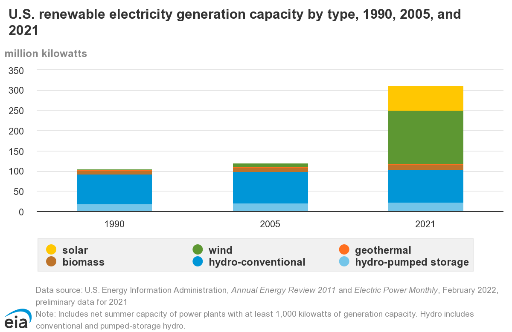Fifty years ago, the idea of powering your home with a 100% clean and renewable energy source would have sounded like science fiction.
And the idea of saving substantial sums of money by doing so? ...Well, that would have been a pipe dream.
Fast-forward to today, however, and millions of Americans are spending less on energy and helping to save the environment by transitioning to renewable sources.
But, which one should homeowners and small businesses looking for a better bottom line choose?
Are they better off going with solar or wind?
Of course, we have to admit to a little bias here. But, there are some very good reasons that solar panels are fast becoming a regular feature of the American landscape while windmill sightings are still pretty rare.
When it comes to residential projects—unless your circumstances are very peculiar indeed—solar is pretty much guaranteed to provide a far superior return on investment.
Rarity is in the eye of the beholder
Given how common a sight solar panels have become, it may be surprising to learn that if we factor in large-scale industrial facilities, wind power has actually grown substantially more.
According to the latest figures from the US Energy Information Administration, by the end of 2021, total US wind capacity had reached 130 million kilowatts (kW). Total solar capacity, on the other hand, amounted to less than half of that at only 61 million kW.
So, if wind power is over three times more popular than solar, why don't see windmills popping up all over the place?
Well, it's the same reason that hydroelectric dams remain relatively rare even though US hydroelectric capacity—just like wind—also outstrips solar.

Residential vs Industrial Power Generation
To generate wind power, you need two things. A turbine and some wind.
Utility-scale turbines stand at around 300 feet tall. That makes them the same size as the Statue of Liberty and, hence, obviously unsuitable for all but a tiny fraction of homes that are on enough land.
Though residential wind turbines are significantly smaller at around 80 feet, that's still too big for anyone who doesn't have an enormous amount of space.
But even if you're lucky enough to have such a huge spread, average wind speeds of 14 miles an hour just to generate 300 kilowatt-hours (kWh) of energy each month.
Since the average home uses around 900 kWh each month, that means you'll need three of those monstrosities to power it. But, of course, anyone with enough space for three 80 ft windmills is sure to consume a lot more power than the average homeowner.
Turbine space = space ground-mounted solar
So, if you've got a lot of land in a rural area with lots of open space so the wind isn't obstructed, then, sure... it's possible to meet some of your energy needs with a wind turbine.
But, if you do have that much space, it's almost certain that you'll be able to generate all the power you need and more with a much less expensive ground-mounted solar array.
While most residential solar systems are roof-mounted, ground-mounted systems are actually significantly cheaper since there's no need to lug parts or equipment up to a roof.
Even better, since their orientation isn't dependent on your roof, ground-mounted panels can be positioned to sit at the precise direction and angle that will give them maximal exposure to the sun. That means that, apart from significant savings on labor, ground-mounted systems generally require fewer panels as well.
If you're just looking to generate a small bit of supplementary power, smaller wind turbines for residential use are available.
But if you want to a significant amount of clean and renewable energy each month and save a lot of money in the process, solar is really the only way to go.